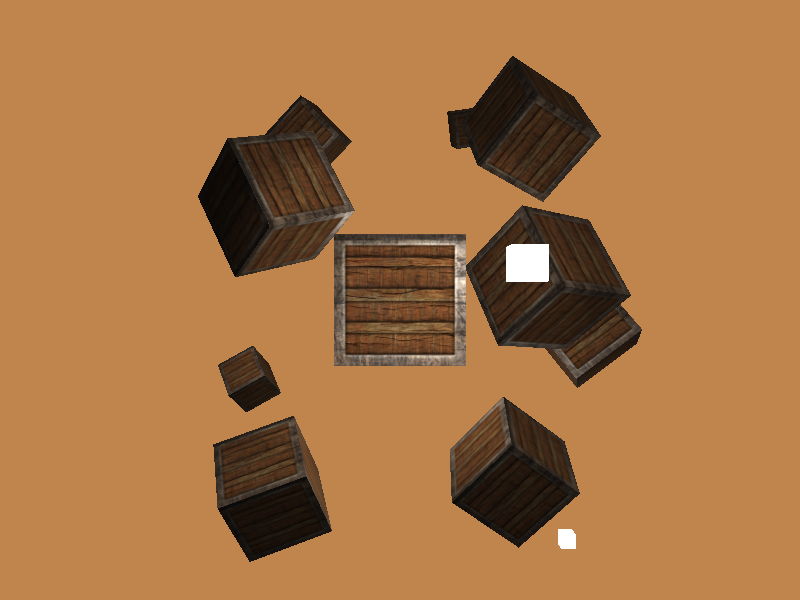
OpenGL实现多光源-附项目源码
效果:

创建一个包含六个光源的场景。将模拟一个类似太阳的定向光(Directional Light)光源,四个分散在场景中的点光源(Point Light),以及一个手电筒(Flashlight)。
为了在场景中使用多个光源,我们希望将光照计算封装到GLSL函数中。这样做的原因是,每一种光源都需要一种不同的计算方法,而一旦我们想对多个光源进行光照计算时,代码很快就会变得非常复杂。如果我们只在main函数中进行所有的这些计算,代码很快就会变得难以理解。
GLSL中的函数和C函数很相似,它有一个函数名、一个返回值类型,如果函数不是在main函数之前声明的,我们还必须在代码文件顶部声明一个原型。我们对每个光照类型都创建一个不同的函数:定向光、点光源和聚光。
当我们在场景中使用多个光源时,我们需要有一个单独的颜色向量代表片段的输出颜色。对于每一个光源,它对片段的贡献颜色将会加到片段的输出颜色向量上。所以场景中的每个光源都会计算它们各自对片段的影响,并结合为一个最终的输出颜色。
1.主要实现代码:
main.cpp
#include <glad/glad.h>
#include <GLFW/glfw3.h>
#include <stb_image.h>
#include <glm/glm.hpp>
#include <glm/gtc/matrix_transform.hpp>
#include <glm/gtc/type_ptr.hpp>
#include <learnopengl/shader_m.h>
#include <learnopengl/camera.h>
#include <iostream>
void framebuffer_size_callback(GLFWwindow* window, int width, int height);
void mouse_callback(GLFWwindow* window, double xpos, double ypos);
void scroll_callback(GLFWwindow* window, double xoffset, double yoffset);
void processInput(GLFWwindow *window);
unsigned int loadTexture(const char *path);
// settings
const unsigned int SCR_WIDTH = 800;
const unsigned int SCR_HEIGHT = 600;
// camera
Camera camera(glm::vec3(0.0f, 0.0f, 3.0f));
float lastX = SCR_WIDTH / 2.0f;
float lastY = SCR_HEIGHT / 2.0f;
bool firstMouse = true;
// timing
float deltaTime = 0.0f;
float lastFrame = 0.0f;
// lighting
glm::vec3 lightPos(1.2f, 1.0f, 2.0f);
int main()
{
// glfw: initialize and configure
// ------------------------------
glfwInit();
glfwWindowHint(GLFW_CONTEXT_VERSION_MAJOR, 3);
glfwWindowHint(GLFW_CONTEXT_VERSION_MINOR, 3);
glfwWindowHint(GLFW_OPENGL_PROFILE, GLFW_OPENGL_CORE_PROFILE);
#ifdef __APPLE__
glfwWindowHint(GLFW_OPENGL_FORWARD_COMPAT, GL_TRUE);
#endif
// glfw window creation
// --------------------
GLFWwindow* window = glfwCreateWindow(SCR_WIDTH, SCR_HEIGHT, "LearnOpenGL", NULL, NULL);
if (window == NULL)
{
std::cout << "Failed to create GLFW window" << std::endl;
glfwTerminate();
return -1;
}
glfwMakeContextCurrent(window);
glfwSetFramebufferSizeCallback(window, framebuffer_size_callback);
glfwSetCursorPosCallback(window, mouse_callback);
glfwSetScrollCallback(window, scroll_callback);
// tell GLFW to capture our mouse
glfwSetInputMode(window, GLFW_CURSOR, GLFW_CURSOR_DISABLED);
// glad: load all OpenGL function pointers
// ---------------------------------------
if (!gladLoadGLLoader((GLADloadproc)glfwGetProcAddress))
{
std::cout << "Failed to initialize GLAD" << std::endl;
return -1;
}
// configure global opengl state
// -----------------------------
glEnable(GL_DEPTH_TEST);
// build and compile our shader zprogram
// ------------------------------------
Shader lightingShader("6.multiple_lights.vs", "6.multiple_lights.fs");
Shader lightCubeShader("6.light_cube.vs", "6.light_cube.fs");
// set up vertex data (and buffer(s)) and configure vertex attributes
// ------------------------------------------------------------------
float vertices[] = {
// positions // normals // texture coords
-0.5f, -0.5f, -0.5f, 0.0f, 0.0f, -1.0f, 0.0f, 0.0f,
0.5f, -0.5f, -0.5f, 0.0f, 0.0f, -1.0f, 1.0f, 0.0f,
0.5f, 0.5f, -0.5f, 0.0f, 0.0f, -1.0f, 1.0f, 1.0f,
0.5f, 0.5f, -0.5f, 0.0f, 0.0f, -1.0f, 1.0f, 1.0f,
-0.5f, 0.5f, -0.5f, 0.0f, 0.0f, -1.0f, 0.0f, 1.0f,
-0.5f, -0.5f, -0.5f, 0.0f, 0.0f, -1.0f, 0.0f, 0.0f,
-0.5f, -0.5f, 0.5f, 0.0f, 0.0f, 1.0f, 0.0f, 0.0f,
0.5f, -0.5f, 0.5f, 0.0f, 0.0f, 1.0f, 1.0f, 0.0f,
0.5f, 0.5f, 0.5f, 0.0f, 0.0f, 1.0f, 1.0f, 1.0f,
0.5f, 0.5f, 0.5f, 0.0f, 0.0f, 1.0f, 1.0f, 1.0f,
-0.5f, 0.5f, 0.5f, 0.0f, 0.0f, 1.0f, 0.0f, 1.0f,
-0.5f, -0.5f, 0.5f, 0.0f, 0.0f, 1.0f, 0.0f, 0.0f,
-0.5f, 0.5f, 0.5f, -1.0f, 0.0f, 0.0f, 1.0f, 0.0f,
-0.5f, 0.5f, -0.5f, -1.0f, 0.0f, 0.0f, 1.0f, 1.0f,
-0.5f, -0.5f, -0.5f, -1.0f, 0.0f, 0.0f, 0.0f, 1.0f,
-0.5f, -0.5f, -0.5f, -1.0f, 0.0f, 0.0f, 0.0f, 1.0f,
-0.5f, -0.5f, 0.5f, -1.0f, 0.0f, 0.0f, 0.0f, 0.0f,
-0.5f, 0.5f, 0.5f, -1.0f, 0.0f, 0.0f, 1.0f, 0.0f,
0.5f, 0.5f, 0.5f, 1.0f, 0.0f, 0.0f, 1.0f, 0.0f,
0.5f, 0.5f, -0.5f, 1.0f, 0.0f, 0.0f, 1.0f, 1.0f,
0.5f, -0.5f, -0.5f, 1.0f, 0.0f, 0.0f, 0.0f, 1.0f,
0.5f, -0.5f, -0.5f, 1.0f, 0.0f, 0.0f, 0.0f, 1.0f,
0.5f, -0.5f, 0.5f, 1.0f, 0.0f, 0.0f, 0.0f, 0.0f,
0.5f, 0.5f, 0.5f, 1.0f, 0.0f, 0.0f, 1.0f, 0.0f,
-0.5f, -0.5f, -0.5f, 0.0f, -1.0f, 0.0f, 0.0f, 1.0f,
0.5f, -0.5f, -0.5f, 0.0f, -1.0f, 0.0f, 1.0f, 1.0f,
0.5f, -0.5f, 0.5f, 0.0f, -1.0f, 0.0f, 1.0f, 0.0f,
0.5f, -0.5f, 0.5f, 0.0f, -1.0f, 0.0f, 1.0f, 0.0f,
-0.5f, -0.5f, 0.5f, 0.0f, -1.0f, 0.0f, 0.0f, 0.0f,
-0.5f, -0.5f, -0.5f, 0.0f, -1.0f, 0.0f, 0.0f, 1.0f,
-0.5f, 0.5f, -0.5f, 0.0f, 1.0f, 0.0f, 0.0f, 1.0f,
0.5f, 0.5f, -0.5f, 0.0f, 1.0f, 0.0f, 1.0f, 1.0f,
0.5f, 0.5f, 0.5f, 0.0f, 1.0f, 0.0f, 1.0f, 0.0f,
0.5f, 0.5f, 0.5f, 0.0f, 1.0f, 0.0f, 1.0f, 0.0f,
-0.5f, 0.5f, 0.5f, 0.0f, 1.0f, 0.0f, 0.0f, 0.0f,
-0.5f, 0.5f, -0.5f, 0.0f, 1.0f, 0.0f, 0.0f, 1.0f
};
// positions all containers
glm::vec3 cubePositions[] = {
glm::vec3( 0.0f, 0.0f, 0.0f),
glm::vec3( 2.0f, 5.0f, -15.0f),
glm::vec3(-1.5f, -2.2f, -2.5f),
glm::vec3(-3.8f, -2.0f, -12.3f),
glm::vec3( 2.4f, -0.4f, -3.5f),
glm::vec3(-1.7f, 3.0f, -7.5f),
glm::vec3( 1.3f, -2.0f, -2.5f),
glm::vec3( 1.5f, 2.0f, -2.5f),
glm::vec3( 1.5f, 0.2f, -1.5f),
glm::vec3(-1.3f, 1.0f, -1.5f)
};
// positions of the point lights
glm::vec3 pointLightPositions[] = {
glm::vec3( 0.7f, 0.2f, 2.0f),
glm::vec3( 2.3f, -3.3f, -4.0f),
glm::vec3(-4.0f, 2.0f, -12.0f),
glm::vec3( 0.0f, 0.0f, -3.0f)
};
// first, configure the cube's VAO (and VBO)
unsigned int VBO, cubeVAO;
glGenVertexArrays(1, &cubeVAO);
glGenBuffers(1, &VBO);
glBindBuffer(GL_ARRAY_BUFFER, VBO);
glBufferData(GL_ARRAY_BUFFER, sizeof(vertices), vertices, GL_STATIC_DRAW);
glBindVertexArray(cubeVAO);
glVertexAttribPointer(0, 3, GL_FLOAT, GL_FALSE, 8 * sizeof(float), (void*)0);
glEnableVertexAttribArray(0);
glVertexAttribPointer(1, 3, GL_FLOAT, GL_FALSE, 8 * sizeof(float), (void*)(3 * sizeof(float)));
glEnableVertexAttribArray(1);
glVertexAttribPointer(2, 2, GL_FLOAT, GL_FALSE, 8 * sizeof(float), (void*)(6 * sizeof(float)));
glEnableVertexAttribArray(2);
// second, configure the light's VAO (VBO stays the same; the vertices are the same for the light object which is also a 3D cube)
unsigned int lightCubeVAO;
glGenVertexArrays(1, &lightCubeVAO);
glBindVertexArray(lightCubeVAO);
glBindBuffer(GL_ARRAY_BUFFER, VBO);
// note that we update the lamp's position attribute's stride to reflect the updated buffer data
glVertexAttribPointer(0, 3, GL_FLOAT, GL_FALSE, 8 * sizeof(float), (void*)0);
glEnableVertexAttribArray(0);
// load textures (we now use a utility function to keep the code more organized)
// -----------------------------------------------------------------------------
unsigned int diffuseMap = loadTexture(FileSystem::getPath("resources/textures/container2.png").c_str());
unsigned int specularMap = loadTexture(FileSystem::getPath("resources/textures/container2_specular.png").c_str());
// shader configuration
// --------------------
lightingShader.use();
lightingShader.setInt("material.diffuse", 0);
lightingShader.setInt("material.specular", 1);
// render loop
// -----------
while (!glfwWindowShouldClose(window))
{
// per-frame time logic
// --------------------
float currentFrame = glfwGetTime();
deltaTime = currentFrame - lastFrame;
lastFrame = currentFrame;
// input
// -----
processInput(window);
// render
// ------
glClearColor(0.1f, 0.1f, 0.1f, 1.0f);
glClear(GL_COLOR_BUFFER_BIT | GL_DEPTH_BUFFER_BIT);
// be sure to activate shader when setting uniforms/drawing objects
lightingShader.use();
lightingShader.setVec3("viewPos", camera.Position);
lightingShader.setFloat("material.shininess", 32.0f);
/*
Here we set all the uniforms for the 5/6 types of lights we have. We have to set them manually and index
the proper PointLight struct in the array to set each uniform variable. This can be done more code-friendly
by defining light types as classes and set their values in there, or by using a more efficient uniform approach
by using 'Uniform buffer objects', but that is something we'll discuss in the 'Advanced GLSL' tutorial.
*/
// directional light
lightingShader.setVec3("dirLight.direction", -0.2f, -1.0f, -0.3f);
lightingShader.setVec3("dirLight.ambient", 0.05f, 0.05f, 0.05f);
lightingShader.setVec3("dirLight.diffuse", 0.4f, 0.4f, 0.4f);
lightingShader.setVec3("dirLight.specular", 0.5f, 0.5f, 0.5f);
// point light 1
lightingShader.setVec3("pointLights[0].position", pointLightPositions[0]);
lightingShader.setVec3("pointLights[0].ambient", 0.05f, 0.05f, 0.05f);
lightingShader.setVec3("pointLights[0].diffuse", 0.8f, 0.8f, 0.8f);
lightingShader.setVec3("pointLights[0].specular", 1.0f, 1.0f, 1.0f);
lightingShader.setFloat("pointLights[0].constant", 1.0f);
lightingShader.setFloat("pointLights[0].linear", 0.09);
lightingShader.setFloat("pointLights[0].quadratic", 0.032);
// point light 2
lightingShader.setVec3("pointLights[1].position", pointLightPositions[1]);
lightingShader.setVec3("pointLights[1].ambient", 0.05f, 0.05f, 0.05f);
lightingShader.setVec3("pointLights[1].diffuse", 0.8f, 0.8f, 0.8f);
lightingShader.setVec3("pointLights[1].specular", 1.0f, 1.0f, 1.0f);
lightingShader.setFloat("pointLights[1].constant", 1.0f);
lightingShader.setFloat("pointLights[1].linear", 0.09);
lightingShader.setFloat("pointLights[1].quadratic", 0.032);
// point light 3
lightingShader.setVec3("pointLights[2].position", pointLightPositions[2]);
lightingShader.setVec3("pointLights[2].ambient", 0.05f, 0.05f, 0.05f);
lightingShader.setVec3("pointLights[2].diffuse", 0.8f, 0.8f, 0.8f);
lightingShader.setVec3("pointLights[2].specular", 1.0f, 1.0f, 1.0f);
lightingShader.setFloat("pointLights[2].constant", 1.0f);
lightingShader.setFloat("pointLights[2].linear", 0.09);
lightingShader.setFloat("pointLights[2].quadratic", 0.032);
// point light 4
lightingShader.setVec3("pointLights[3].position", pointLightPositions[3]);
lightingShader.setVec3("pointLights[3].ambient", 0.05f, 0.05f, 0.05f);
lightingShader.setVec3("pointLights[3].diffuse", 0.8f, 0.8f, 0.8f);
lightingShader.setVec3("pointLights[3].specular", 1.0f, 1.0f, 1.0f);
lightingShader.setFloat("pointLights[3].constant", 1.0f);
lightingShader.setFloat("pointLights[3].linear", 0.09);
lightingShader.setFloat("pointLights[3].quadratic", 0.032);
// spotLight
lightingShader.setVec3("spotLight.position", camera.Position);
lightingShader.setVec3("spotLight.direction", camera.Front);
lightingShader.setVec3("spotLight.ambient", 0.0f, 0.0f, 0.0f);
lightingShader.setVec3("spotLight.diffuse", 1.0f, 1.0f, 1.0f);
lightingShader.setVec3("spotLight.specular", 1.0f, 1.0f, 1.0f);
lightingShader.setFloat("spotLight.constant", 1.0f);
lightingShader.setFloat("spotLight.linear", 0.09);
lightingShader.setFloat("spotLight.quadratic", 0.032);
lightingShader.setFloat("spotLight.cutOff", glm::cos(glm::radians(12.5f)));
lightingShader.setFloat("spotLight.outerCutOff", glm::cos(glm::radians(15.0f)));
// view/projection transformations
glm::mat4 projection = glm::perspective(glm::radians(camera.Zoom), (float)SCR_WIDTH / (float)SCR_HEIGHT, 0.1f, 100.0f);
glm::mat4 view = camera.GetViewMatrix();
lightingShader.setMat4("projection", projection);
lightingShader.setMat4("view", view);
// world transformation
glm::mat4 model = glm::mat4(1.0f);
lightingShader.setMat4("model", model);
// bind diffuse map
glActiveTexture(GL_TEXTURE0);
glBindTexture(GL_TEXTURE_2D, diffuseMap);
// bind specular map
glActiveTexture(GL_TEXTURE1);
glBindTexture(GL_TEXTURE_2D, specularMap);
// render containers
glBindVertexArray(cubeVAO);
for (unsigned int i = 0; i < 10; i++)
{
// calculate the model matrix for each object and pass it to shader before drawing
glm::mat4 model = glm::mat4(1.0f);
model = glm::translate(model, cubePositions[i]);
float angle = 20.0f * i;
model = glm::rotate(model, glm::radians(angle), glm::vec3(1.0f, 0.3f, 0.5f));
lightingShader.setMat4("model", model);
glDrawArrays(GL_TRIANGLES, 0, 36);
}
// also draw the lamp object(s)
lightCubeShader.use();
lightCubeShader.setMat4("projection", projection);
lightCubeShader.setMat4("view", view);
// we now draw as many light bulbs as we have point lights.
glBindVertexArray(lightCubeVAO);
for (unsigned int i = 0; i < 4; i++)
{
model = glm::mat4(1.0f);
model = glm::translate(model, pointLightPositions[i]);
model = glm::scale(model, glm::vec3(0.2f)); // Make it a smaller cube
lightCubeShader.setMat4("model", model);
glDrawArrays(GL_TRIANGLES, 0, 36);
}
// glfw: swap buffers and poll IO events (keys pressed/released, mouse moved etc.)
// -------------------------------------------------------------------------------
glfwSwapBuffers(window);
glfwPollEvents();
}
// optional: de-allocate all resources once they've outlived their purpose:
// ------------------------------------------------------------------------
glDeleteVertexArrays(1, &cubeVAO);
glDeleteVertexArrays(1, &lightCubeVAO);
glDeleteBuffers(1, &VBO);
// glfw: terminate, clearing all previously allocated GLFW resources.
// ------------------------------------------------------------------
glfwTerminate();
return 0;
}
// process all input: query GLFW whether relevant keys are pressed/released this frame and react accordingly
// ---------------------------------------------------------------------------------------------------------
void processInput(GLFWwindow *window)
{
if (glfwGetKey(window, GLFW_KEY_ESCAPE) == GLFW_PRESS)
glfwSetWindowShouldClose(window, true);
if (glfwGetKey(window, GLFW_KEY_W) == GLFW_PRESS)
camera.ProcessKeyboard(FORWARD, deltaTime);
if (glfwGetKey(window, GLFW_KEY_S) == GLFW_PRESS)
camera.ProcessKeyboard(BACKWARD, deltaTime);
if (glfwGetKey(window, GLFW_KEY_A) == GLFW_PRESS)
camera.ProcessKeyboard(LEFT, deltaTime);
if (glfwGetKey(window, GLFW_KEY_D) == GLFW_PRESS)
camera.ProcessKeyboard(RIGHT, deltaTime);
}
// glfw: whenever the window size changed (by OS or user resize) this callback function executes
// ---------------------------------------------------------------------------------------------
void framebuffer_size_callback(GLFWwindow* window, int width, int height)
{
// make sure the viewport matches the new window dimensions; note that width and
// height will be significantly larger than specified on retina displays.
glViewport(0, 0, width, height);
}
// glfw: whenever the mouse moves, this callback is called
// -------------------------------------------------------
void mouse_callback(GLFWwindow* window, double xpos, double ypos)
{
if (firstMouse)
{
lastX = xpos;
lastY = ypos;
firstMouse = false;
}
float xoffset = xpos - lastX;
float yoffset = lastY - ypos; // reversed since y-coordinates go from bottom to top
lastX = xpos;
lastY = ypos;
camera.ProcessMouseMovement(xoffset, yoffset);
}
// glfw: whenever the mouse scroll wheel scrolls, this callback is called
// ----------------------------------------------------------------------
void scroll_callback(GLFWwindow* window, double xoffset, double yoffset)
{
camera.ProcessMouseScroll(yoffset);
}
// utility function for loading a 2D texture from file
// ---------------------------------------------------
unsigned int loadTexture(char const * path)
{
unsigned int textureID;
glGenTextures(1, &textureID);
int width, height, nrComponents;
unsigned char *data = stbi_load(path, &width, &height, &nrComponents, 0);
if (data)
{
GLenum format;
if (nrComponents == 1)
format = GL_RED;
else if (nrComponents == 3)
format = GL_RGB;
else if (nrComponents == 4)
format = GL_RGBA;
glBindTexture(GL_TEXTURE_2D, textureID);
glTexImage2D(GL_TEXTURE_2D, 0, format, width, height, 0, format, GL_UNSIGNED_BYTE, data);
glGenerateMipmap(GL_TEXTURE_2D);
glTexParameteri(GL_TEXTURE_2D, GL_TEXTURE_WRAP_S, GL_REPEAT);
glTexParameteri(GL_TEXTURE_2D, GL_TEXTURE_WRAP_T, GL_REPEAT);
glTexParameteri(GL_TEXTURE_2D, GL_TEXTURE_MIN_FILTER, GL_LINEAR_MIPMAP_LINEAR);
glTexParameteri(GL_TEXTURE_2D, GL_TEXTURE_MAG_FILTER, GL_LINEAR);
stbi_image_free(data);
}
else
{
std::cout << "Texture failed to load at path: " << path << std::endl;
stbi_image_free(data);
}
return textureID;
}
2.完整的项目代码 VS2012
链接:https://pan.baidu.com/s/17sjY756zaTE3yaWsG55JWA 提取码:9nmh
3.参考资料
https://learnopengl-cn.github.io/02%20Lighting/06%20Multiple%20lights/

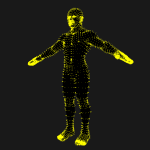
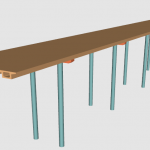
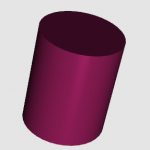
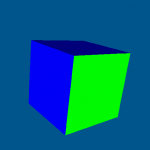
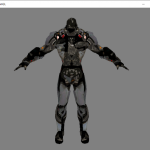
One thought on “OpenGL实现多光源-附项目源码”
Great